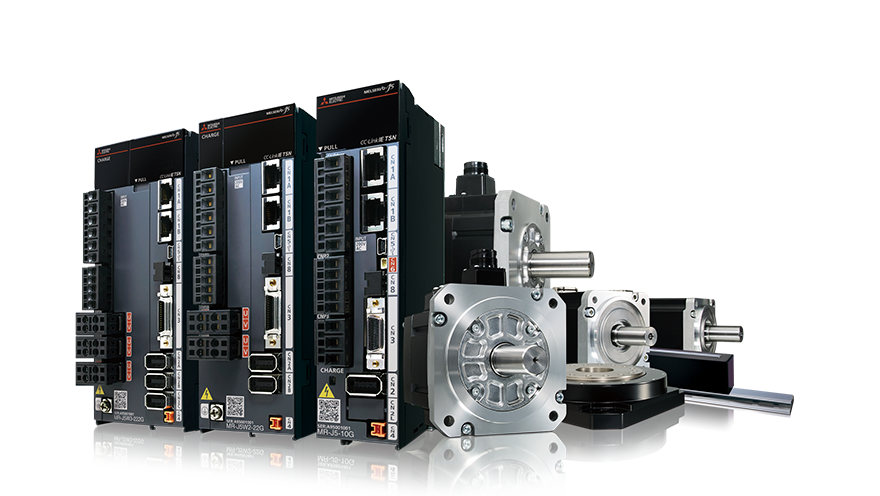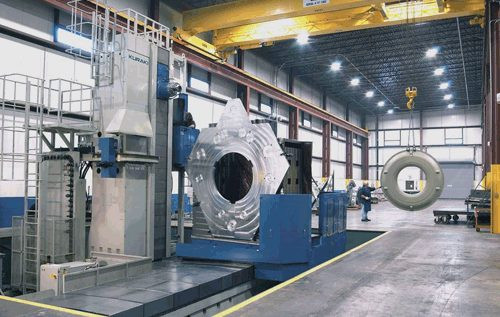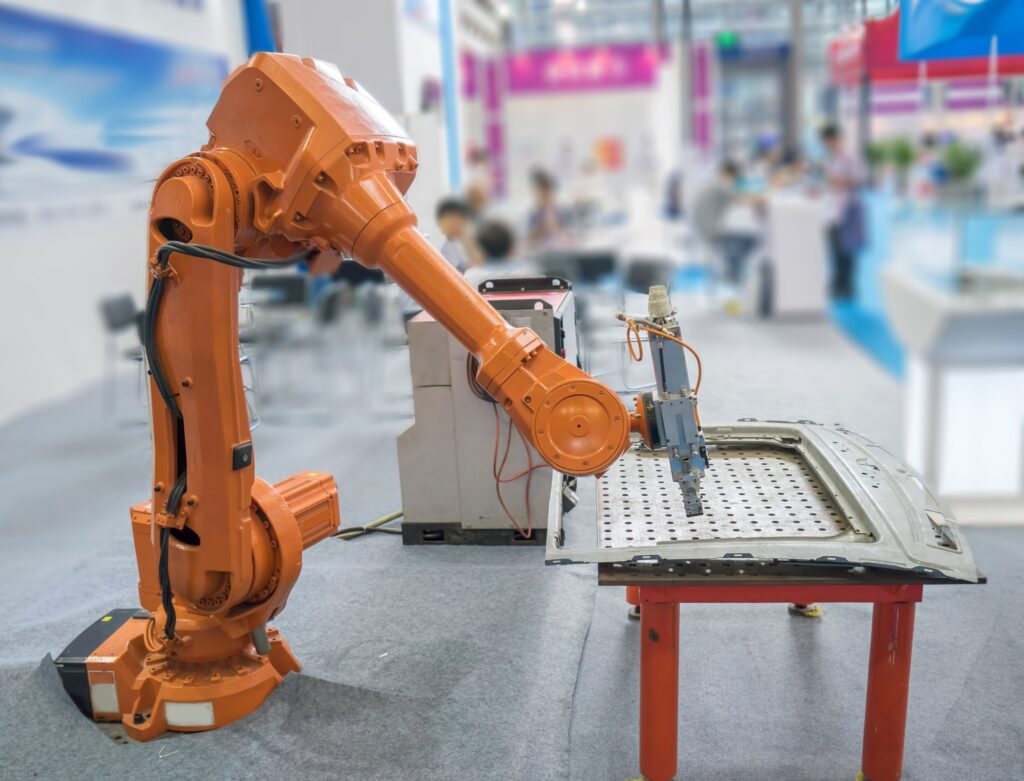
1
What is a Servo Motor and How it Works
What is a Servo Motor and How it Works
Servo Motors: Precision and Versatility
Servo motors are the driving force behind countless industrial automation applications, prized for their accuracy, responsiveness, and adaptability. Whether it’s positioning a robotic arm or regulating the speed of a conveyor system, servo motors offer unmatched control over motion.
Their built-in feedback systems—typically using encoders or resolvers—allow for real-time monitoring and adjustment, ensuring precise movements even under changing loads. This closed-loop control makes them ideal for applications that demand high precision and repeatability.
In high-speed environments like CNC machining and electronics assembly, the integration of servo motors with advanced control systems enhances overall performance. Pairing these motors with Mitsubishi Electric PLCs or Q Series modular PLCs enables precise coordination across complex automation tasks. When combined with Variable Speed Drives, systems can dynamically adjust motor output for optimal energy efficiency. For operations requiring both motion control and safety compliance, components like Safety Light Curtains ensure protection without slowing production. To better understand the synergy between these elements, explore our blog post on Servo Motors and Their Applications.
What Are Servo Motors?
Origins and Development
Servo motors have their roots in early control systems, where precise motion was critical—such as in naval gun targeting and aerospace technology. As automation advanced, the demand for compact, high-performance motors grew, leading to the development of the modern servo motor. These motors quickly found their place in industrial automation, robotics, and CNC machinery, where accurate positioning and rapid response are essential.
Over time, servo motor technology has evolved significantly. Innovations in digital control, feedback systems, and compact motor design have expanded their use beyond heavy industry. Today, they are commonly found in everything from automated manufacturing lines and packaging equipment to medical devices and camera systems—wherever motion control and high precision are required.
Basic Structure and Components
A servo motor is composed of several core components that work together to deliver controlled motion:
- Motor: Typically a DC or AC motor that provides the basic rotational movement.
- Encoder or Resolver: These sensors track position, speed, and direction, enabling closed-loop feedback.
- Controller: Receives input commands and adjusts motor output accordingly, ensuring precision.
- Drive (Amplifier): Converts control signals into power levels suitable for the motor.
This closed-loop system allows servo motors to make constant real-time adjustments, maintaining exact positioning even in dynamic or high-speed environments. The combination of feedback and control is what sets servo motors apart in motion control applications, offering the accuracy and reliability demanded in modern automation systems.
Types of Servo Motors
AC vs. DC Servo Motors
AC vs. DC Servo Motors
Servo motors are generally classified by the type of electrical current they use—AC (alternating current) or DC (direct current).
AC servo motors are widely used in industrial automation due to their ability to handle higher current, torque, and speed. They are ideal for high-performance applications such as robotics, CNC machines, and conveyor systems.
DC servo motors, on the other hand, are often found in smaller-scale or battery-operated devices, like camera auto-focus mechanisms or compact medical instruments. They offer simpler control and are easier to integrate into low-voltage environments, though they may require more maintenance over time.
Both types provide excellent motion control, but the choice between AC and DC servo motors depends largely on the specific performance and application requirements.
Brushed and Brushless Motors
Brushed and Brushless Motors
Another important distinction among servo motors is whether they are brushed or brushless.
Brushed servo motors use physical brushes and a commutator to transfer current, making them simpler and less expensive. However, the brushes wear out over time, requiring periodic maintenance. They’re typically used in basic automation tasks and hobby robotics where low cost and simplicity are priorities.
Brushless servo motors eliminate the need for brushes, offering higher efficiency, longer lifespan, and quieter operation. These motors are common in precision industrial equipment, packaging systems, and advanced automation where performance and reliability are critical.
Brushless technology has become the preferred choice for many industrial applications, especially where continuous operation and minimal downtime are essential.
Synchronous and Asynchronous Motors
Synchronous and Asynchronous Motors
In the realm of AC servo motors, you’ll often hear the terms synchronous and asynchronous.
Synchronous servo motors operate with a rotor that moves in perfect sync with the stator’s magnetic field. This allows for exact control over position and speed, making them ideal for applications like pick-and-place robotics, 3D printing, and high-speed cutting machines.
Asynchronous (induction) motors allow a slight lag between rotor and magnetic field, making them less precise but more rugged and cost-effective. They’re suitable for simpler automation tasks where ultra-high accuracy isn’t as critical.
Choosing between synchronous and asynchronous motors depends on the desired balance between performance, precision, and budget.
Linear Servo Motors: Iron-Core vs. Ironless
Linear Servo Motors: Iron-Core vs. Ironless
Linear servo motors convert electrical energy directly into linear motion, eliminating the need for mechanical linkages like belts or screws. They’re common in semiconductor manufacturing, precision inspection systems, and high-speed automation lines.
Iron-core linear servo motors have a stator made with laminated iron, providing high force density. However, they can experience cogging—small jerky movements caused by magnetic attraction—which may affect ultra-smooth motion.
Ironless linear motors, with no iron in the stator, offer exceptionally smooth and precise motion with virtually no cogging. This makes them ideal for applications requiring ultra-fine positioning, such as in metrology equipment or laser processing systems.
Each type offers unique advantages depending on the application’s speed, force, and smoothness requirements.
AC vs. DC Servo Motors
Servo motors are generally classified by the type of electrical current they use—AC (alternating current) or DC (direct current).
AC servo motors are widely used in industrial automation due to their ability to handle higher current, torque, and speed. They are ideal for high-performance applications such as robotics, CNC machines, and conveyor systems.
DC servo motors, on the other hand, are often found in smaller-scale or battery-operated devices, like camera auto-focus mechanisms or compact medical instruments. They offer simpler control and are easier to integrate into low-voltage environments, though they may require more maintenance over time.
Both types provide excellent motion control, but the choice between AC and DC servo motors depends largely on the specific performance and application requirements.
Brushed and Brushless Motors
Another important distinction among servo motors is whether they are brushed or brushless.
Brushed servo motors use physical brushes and a commutator to transfer current, making them simpler and less expensive. However, the brushes wear out over time, requiring periodic maintenance. They’re typically used in basic automation tasks and hobby robotics where low cost and simplicity are priorities.
Brushless servo motors eliminate the need for brushes, offering higher efficiency, longer lifespan, and quieter operation. These motors are common in precision industrial equipment, packaging systems, and advanced automation where performance and reliability are critical.
Brushless technology has become the preferred choice for many industrial applications, especially where continuous operation and minimal downtime are essential.
Synchronous and Asynchronous Motors
In the realm of AC servo motors, you’ll often hear the terms synchronous and asynchronous.
Synchronous servo motors operate with a rotor that moves in perfect sync with the stator’s magnetic field. This allows for exact control over position and speed, making them ideal for applications like pick-and-place robotics, 3D printing, and high-speed cutting machines.
Asynchronous (induction) motors allow a slight lag between rotor and magnetic field, making them less precise but more rugged and cost-effective. They’re suitable for simpler automation tasks where ultra-high accuracy isn’t as critical.
Choosing between synchronous and asynchronous motors depends on the desired balance between performance, precision, and budget.
Linear Servo Motors: Iron-Core vs. Ironless
Linear servo motors convert electrical energy directly into linear motion, eliminating the need for mechanical linkages like belts or screws. They’re common in semiconductor manufacturing, precision inspection systems, and high-speed automation lines.
Iron-core linear servo motors have a stator made with laminated iron, providing high force density. However, they can experience cogging—small jerky movements caused by magnetic attraction—which may affect ultra-smooth motion.
Ironless linear motors, with no iron in the stator, offer exceptionally smooth and precise motion with virtually no cogging. This makes them ideal for applications requiring ultra-fine positioning, such as in metrology equipment or laser processing systems.
Each type offers unique advantages depending on the application’s speed, force, and smoothness requirements.
How Servo Motors Work
Signal Transmission and Processing
The operation of a servo motor begins with a control signal—typically a pulse-width modulated (PWM) signal—sent from a controller, such as a PLC or motion controller. This signal communicates the desired position, speed, or torque. In industrial automation, these signals are part of a coordinated system, where multiple servo motors may respond simultaneously for synchronized motion.
Once received, the signal is interpreted and processed by the servo drive, which determines how much power should be delivered to the motor. This seamless communication between controller and motor enables real-time motion control, a critical feature in robotics, CNC systems, and precision assembly applications.
Servo Drives and Motor Activation
The servo drive, sometimes called an amplifier, acts as the brain between the control system and the servo motor. It converts low-voltage control signals into high-power outputs that energize the motor windings.
By continuously adjusting the voltage and current supplied to the motor, the drive ensures the motor responds smoothly to changes in speed or position. In automation systems, this allows for rapid acceleration, deceleration, and directional shifts without sacrificing stability or control.
Modern servo drives also offer integrated diagnostics and communication capabilities, making them an essential component of smart factory environments and Industry 4.0 systems.
Feedback Mechanisms for Precision
A defining feature of servo motors is their use of closed-loop feedback. Devices like encoders or resolvers are attached to the motor shaft and constantly monitor its position, speed, and direction. This feedback is sent back to the controller or drive, which compares the actual performance with the intended command.
If there’s any deviation—such as a slight overshoot or external disturbance—the system corrects it instantly. This dynamic feedback loop ensures the high precision and repeatability that servo motors are known for, even under varying loads or complex motion sequences.
In high-precision industries like electronics manufacturing or automated inspection, this level of control is crucial for maintaining product quality and process reliability.
Servo Motors vs. Stepper Motors
Differences in Torque and Speed Performance
While both servo motors and stepper motors are used for motion control, they differ significantly in how they handle torque and speed—two key factors in industrial automation.
Servo motors excel in delivering high torque across a wide speed range. Thanks to their closed-loop feedback systems, they can adjust dynamically to load changes, maintaining torque and precision even at high speeds. This makes them ideal for demanding applications like robotic arms, conveyor systems, and CNC machines, where consistent power and responsiveness are critical.
Stepper motors, by contrast, operate in an open-loop configuration and offer high torque at low speeds. They’re well-suited for simpler tasks such as 3D printing, basic positioning systems, or lab automation equipment. However, their torque drops off rapidly as speed increases, and without feedback, they can lose steps under load—leading to positioning errors.
In environments where performance under variable conditions is essential, servo motors provide superior control and reliability, while stepper motors remain a cost-effective choice for low-speed, low-complexity operations.
Applications of Servo Motors
Robotics
Servo motors play a central role in robotics, where precision, speed, and flexibility are essential. From multi-axis robotic arms to mobile robots and humanoid platforms, servo motors enable precise control over joint movement and positioning. Their ability to respond to real-time feedback allows robots to perform complex, delicate tasks such as soldering micro-components or assembling intricate parts on high-speed production lines. In industrial automation, servo-driven robots boost efficiency, reduce errors, and improve repeatability across repetitive and high-precision workflows.
CNC Machinery
In CNC (Computer Numerical Control) systems, servo motors are the backbone of accurate, dynamic motion control. Whether it’s milling, lathing, or laser cutting, CNC machines rely on servo motors to deliver fast and precise tool movement along multiple axes. The closed-loop system ensures consistent torque and exact positioning, even during rapid direction changes or variable material resistance. This level of control is vital for maintaining tight tolerances and high-quality finishes in metalworking, woodworking, and precision manufacturing industries.
Other Industrial Uses
Beyond robotics and CNC machinery, servo motors are widely used across a range of industrial automation applications. In packaging lines, they manage rapid filling, sealing, and labeling operations. In textile manufacturing, they guide fabric through complex stitching and cutting processes. Conveyor systems benefit from servo control for synchronized movement and positioning, especially in sorting and assembly environments. Servo motors are also found in medical devices, semiconductor fabrication, and automated inspection systems—anywhere consistent, high-precision motion is a necessity.
Robotics
Servo motors play a central role in robotics, where precision, speed, and flexibility are essential. From multi-axis robotic arms to mobile robots and humanoid platforms, servo motors enable precise control over joint movement and positioning. Their ability to respond to real-time feedback allows robots to perform complex, delicate tasks such as soldering micro-components or assembling intricate parts on high-speed production lines. In industrial automation, servo-driven robots boost efficiency, reduce errors, and improve repeatability across repetitive and high-precision workflows.
CNC Machinery
In CNC (Computer Numerical Control) systems, servo motors are the backbone of accurate, dynamic motion control. Whether it’s milling, lathing, or laser cutting, CNC machines rely on servo motors to deliver fast and precise tool movement along multiple axes. The closed-loop system ensures consistent torque and exact positioning, even during rapid direction changes or variable material resistance. This level of control is vital for maintaining tight tolerances and high-quality finishes in metalworking, woodworking, and precision manufacturing industries.
Other Industrial Uses
Beyond robotics and CNC machinery, servo motors are widely used across a range of industrial automation applications. In packaging lines, they manage rapid filling, sealing, and labeling operations. In textile manufacturing, they guide fabric through complex stitching and cutting processes. Conveyor systems benefit from servo control for synchronized movement and positioning, especially in sorting and assembly environments. Servo motors are also found in medical devices, semiconductor fabrication, and automated inspection systems—anywhere consistent, high-precision motion is a necessity.
Integration with Technology
Software and Programming Needs
Integrating servo motors into modern automation systems requires more than just hardware—it demands sophisticated software and programming. Motion controllers and PLCs must be programmed to communicate precisely with the servo drive, sending commands and interpreting feedback in real time. This often involves using industrial programming languages like ladder logic, structured text, or function block diagrams.
Servo systems also rely heavily on motion control software to define parameters such as acceleration profiles, positioning limits, and torque thresholds. In applications like robotics or CNC machinery, advanced programming environments enable the creation of synchronized, multi-axis movements with tight tolerances.
Industrial automation platforms such as Siemens TIA Portal, Mitsubishi GX Works, or Rockwell’s Studio 5000 often come with dedicated servo control modules, simplifying setup and diagnostics. However, integrating servo motors still requires skilled personnel with experience in tuning, commissioning, and troubleshooting.
As Industry 4.0 and smart manufacturing evolve, servo motors are increasingly integrated with IoT-enabled devices and cloud-based systems, enabling remote monitoring, predictive maintenance, and data-driven optimization. This tight integration between software and hardware is key to unlocking the full potential of servo motor technology.
Extending Beyond Motion: A Broader Look at Automation Systems
While servo motors are essential for high-precision motion control, they form just one part of a wider industrial automation ecosystem. In addition to safety-related products, Venus Automation stocks a comprehensive range of items focused on advanced automation technologies. These offerings enable cost reduction and improved operational efficiency; however, they do not eliminate the need for hard-wired safety systems, even when certain technologies may appear similar in function. Automation components serve as powerful tools for enhancing productivity across industrial environments.
For example, Programmable Logic Controllers (PLCs) are essential for automating the operation of industrial machinery. Venus Automation supplies a variety of PLCs from Mitsubishi, including the Alpha Series, FX Family Series, Q Series, IQ-R Series, and Networking CC-Link modules—each designed to support specific control and scalability needs. To complement these systems, light curtains for measurement are available, along with a wide selection of encoders. These include absolute encoders, incremental encoders, magnetic encoders, and rotary encoder types, all of which contribute to precise and reliable automation. When paired with compatible motors, variable speed drives offer enhanced motor control, increasing the value of encoder feedback. For even greater precision, servo motors and servo amplifiers are also available, supporting applications that demand accurate motor positioning.
Human-machine interaction is enabled through a full range of operator interface components, including selector switches, HMI touch panels, handheld pendants, industrial-grade pushbuttons, panel mounts, and relevant accessories. Monitoring of electrical circuit performance is supported by devices such as power relays, speed monitors, insulation monitors, current monitors, battery monitors, phase sequence relays, voltage monitoring relays, and undercurrent relays. Additional core components include power supplies and residual current transformer units. EV charging solutions are also available within this category.
Supporting both automation and safety systems is a robust offering of cables and connectors. This includes straight cables, angled cables, and multipole connectors such as REVOS and RST. For secure integration into control panels, Selos terminals are recommended. A complete range of plugs, sockets, inlets, flanges, couplers, and enclosures are also stocked to accommodate diverse industrial applications.

